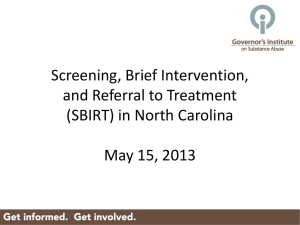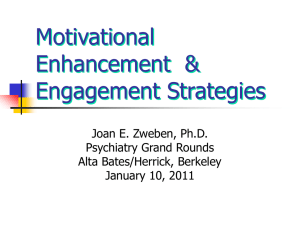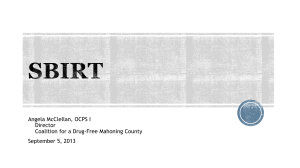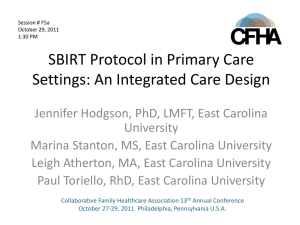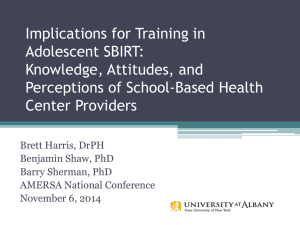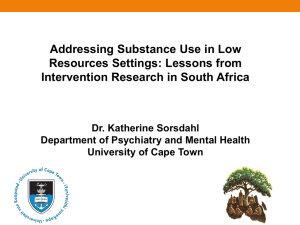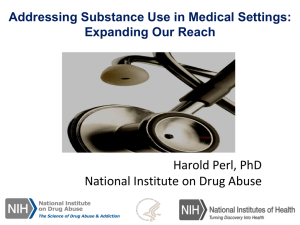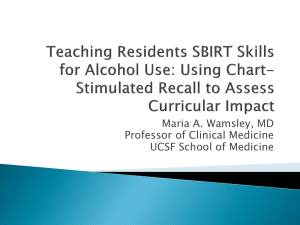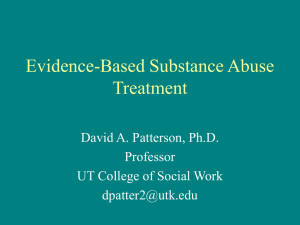State Forum on Screening, Brief Intervention and Referral to Treatment
advertisement
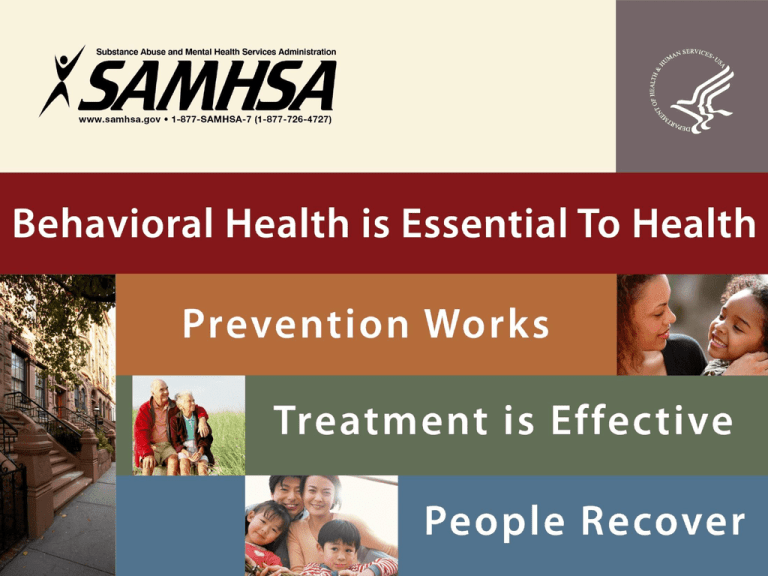
Delivering SBIRT: A “How To” on Screening, Brief Intervention, and Referral to Treatment Presented by Acknowledgements Many persons have provided input into the content and to the creation of this series, including: Dan Alford, MD Edward Bernstein, MD, FACEP David Feillin, MD Joe Hyde, MA, LMHC, CAS Jennifer Kasten, PhD Mike Lardiere, LICSW Paula Lum, MD Bill McFeature, PhD John Muench, MD, MPH Michael Pantalon, PhD Janice Pringle, PhD Rich Saitz, MD James Paul Seale, MD Daniel Vinson, MD, MSPH Welcome Housekeeping Today’s Agenda • 9:00 a.m.—What Is SBIRT and Why? • 10:15 a.m.—Break • 10:30 a.m.—The Business of SBIRT – Implementation in diverse practice settings – Billing and reimbursement • 12:00 p.m.—Lunch (on your own) • 1:30 p.m.—Orientation to the SBIRT Clinical Intervention • 3:00 p.m.—Break • 3:15 p.m.—Continue program • 5:00 p.m.—Adjourn Session 1: What Is SBIRT and Why? By the end of this session participants will able to: • Describe what SBIRT is and its supporting evidence. • Describe its value for patients, payers, policymakers, physicians, and allied health and human service professionals. • Better answer the question: Why might I choose to support SBIRT implementation? SBIRT Defined Screening, Brief Intervention, and Referral to Treatment (SBIRT) is a comprehensive, integrated, public health approach to the delivery of early intervention and treatment services – For persons with substance use disorders. – For those whose use is at higher levels of risk. Primary care centers, hospitals, and other community settings provide excellent opportunities for early intervention with at risk substance users and for intervention for persons with substance use disorders. Question? Why might I choose to support SBIRT implementation? Continuum of Substance Use Severity ABSTAINERS & LOW RISK USERS (70%) MODERATE TO HIGHER RISK 25% SEVERE and DEPENDENT (5%) Why is SBIRT Important? • Unhealthy and unsafe alcohol and drug use are major preventable public health problems resulting in more than 100,000 deaths each year. • The costs to society are more than $600 billion annually. • Effects of unhealthy and unsafe alcohol and drug use have far-reaching implications for the individual, family, workplace, community, and the health care system. Harms Related to Hazardous Alcohol and Substance Use Increases the risk for: • Injury/trauma • Criminal justice involvement • Social problems • Mental health consequences (e.g., anxiety, depression, etc.) • Increased absenteeism and accidents in the workplace Unfortunately, These Kinds of Experiences Remain too Commonplace Medical and Psychiatric Harm of High Risk Drinking And the Evidence Indicates That Moderate Risk and High Risk Drinkers Account for the MOST Problems High Risk Drinker Moderate Drinkers Health Spouse Light Drinkers 100% 80% 60% 40% 20% 0% Aggression Job Friends Accidents Historic Response to Substance Use Previously, substance use intervention and treatment focused primarily on substance abuse universal prevention strategies and on specialized treatment services for those who met the abuse and dependence criteria. There was a significant gap in service systems for at risk populations. In the Emerging Public Health Paradigm, All Services Are Aligned Primary Prevention Early Intervention Universal Prevention Selective Prevention Indicated Prevention SBIRT and other brief interventions Treatment Evidence-based practices with recovery supports (ROSC) Maintenance Recovery supports, self-help, etc. (ROSC) Goal The primary goal of SBIRT is to identify and effectively intervene with those who are at moderate or high risk for psychosocial or health care problems related to their substance use. Research Demonstrates Effectiveness • A growing body of evidence about SBIRT’s effectiveness—including cost-effectiveness— has demonstrated its positive outcomes. • The research shows that SBIRT is an effective way to reduce drinking and substance abuse problems. Research Shows Brief Interventions: • Are low cost and effective. • Are most effective among persons with less severe problems. • “Brief interventions are feasible and highly effective components of an overall public health approach to reducing alcohol misuse.” (Whitlock et al. 2004, for US Preventive Services Task Force) Making a Measurable Difference • Since 2003, SAMHSA has supported SBIRT programs with over 1.5 million persons screened. • Outcome data confirm a 40% reduction in harmful use of alcohol by those drinking at risky levels and a 55% reduction in negative social consequences. • Outcome data also demonstrate positive benefits for reduced illicit substance use. Based on review of SBIRT GPRA data (2003-2011). SBIRT is a Highly Flexible Intervention SBIRT Settings Aging/Senior Service Behavioral Health Clinic Community Health Center Community Mental Health Center Drug Abuse/Addiction Services Emergency Room FQHC Homeless Facility Hospital Inpatient Primary Care Clinic Psychiatric Clinic School-Based/Student Health Trauma Centers/Trauma Units Urgent Care Veteran’s Hospital Other Agency Sites Medical Specialty Areas So What Is SBIRT? An intervention based on “motivational interviewing” strategies • Screening: Universal screening for quickly assessing use and severity of alcohol, illicit drugs, and prescription drug abuse. • Brief Intervention: Brief motivational and awareness-raising intervention given to risky or problematic substance users. • Referral to Treatment: Referrals to specialty care for patients with substance use disorders. Treatment can consist of brief treatment or specialty AOD treatment. Why Universally Screen? • To detect current health problems related to at risk alcohol and substance use at an early stage, before they result in more serious disease or other health problems. • To detect alcohol and substance use patterns that can increase future injury or illness risks. • To intervene and educate about at risk alcohol and other substance use. Rationale for Universal Screening • Drinking and drug use are common. • Drinking and drug use can increase the risk for health problems, safety risks, and a host of other issues. • Drinking and drug use often go undetected. • People are more open to change than you might expect. Patients Are Open to Discussing Their Substance Use to Help Their Health Survey on Patient Attitudes: Agree/Strongly Agree “If my doctor asked me how much I drink, I would give an honest answer.” 92% “If my drinking is affecting my health, my doctor should advise me to cut down on alcohol.” 96% “As part of my medical care, my doctor should feel free to ask me how much alcohol I drink.” 93% Disagree/Strongly Disagree “I would be annoyed if my doctor asked me how much alcohol I drink.” 86% “I would be embarrassed if my doctor asked me how much alcohol I drink.” 78% Source: Miller, PM, et al. Alcohol & Alcoholism; 2006 Adapted from The Oregon SBIRT Primary Care Residency Initiative training curriculum (www.sbirtoregon.org) Based on Findings of Screening SBIRT Reduces Short- and Long-Term Healthcare Costs • By intervening early, SBIRT saves lives and money. • Late-stage intervention and substance abuse treatment is expensive, and the patient has often developed co-morbid health conditions. SBIRT Decreases the Frequency and Severity of Alcohol and Drug Use Primary care is one of the most convenient points of contact for substance issues. Many patients are more likely to discuss this subject with their family physician than a relative, therapist, or rehab specialist. SBIRT Integrates Primary Care With Behavioral Health in a Medical Home Model Given how widespread substance abuse is nationwide, it makes good sense for primary care practitioners—rather than trauma centers or rehab specialists—to be the first line of substance abuse response. In many areas, primary care practitioners are the only healthcare providers. SBIRT Is an Important Part of Wellness and Prevention Programs • Patients often don’t understand how alcohol and drug use impacts their health, or if the amounts they use are dangerous. • Research from the World Health Organization and the Centers for Disease Control and Prevention has shown that alcohol is a major risk factor for a number of medical, social, and legal problems. • SBIRT opens up a dialogue that can improve your patients’ overall health. So Why is SBIRT Important for Payers and Policymakers? For Payers and Policymakers, SBIRT Makes Good Financial Sense Summary of Findings of the Alcohol Misuse Screening and Behavioral Counseling: Technical Report* submitted to the US Preventative Services Task Force. Average cost for SBIRT intervention: $44.91 Net healthcare cost savings annually per person: $254.00 Net healthcare cost savings per million adults: $254,000,000 *Alcohol Misuse Screening and Behavioral Counseling: Technical Report Prepared for the National Commission on Prevention Priorities (2008), (pp. 20‒22). Michael V. Maciosek, PhD*, Leif I. Solberg, MD*, Nichol M. Edwards, MS*, and Dana A. McGree* under contract from the Centers for Disease Control and Prevention (CDC) and the Agency for Healthcare Research and Quality (AHRQ). SBIRT and Cost Wisconsin SBIRT Cost Benefit Studies • Reduction in hospital costs, ED visits, and associated problems resulted in $1,000 savings per person screened (Primary Care Setting. Fleming, M.F., Med Care, 2000). Texas SBIRT Cost Benefit Studies • A net savings of $4.00 in ED costs for every $1.00 invested in SBIRT screening and brief intervention. ED saw a 50% reduction in recurrent alcohol-related injuries (Gentilello, L.M., Ann Surg, 1999) . Washington State Cost Benefit Studies • Reduction in Medicaid-specific expenditures $185.00 per month per patient who received SBIRT screening and brief intervention (Disabled Medicaid patients in emergency room setting. Estee S. Medicaid Cost Outcomes, Interim Report 4.61.1.2007.2, Washington State Department of Social and Health Services). SBIRT Improves the Health and Welfare of the Whole Community • Improves public safety • Reduces social and workplace problems with at risk users • Reduces family conflict • Supports health and wellness of the whole community Lessons Learned • SBIRT is a brief and highly adaptive evidencebased practice with demonstrated results. • SBIRT has been successfully implemented in diverse sites across the lifespan. • Patients are open to talk with trusted helpers about substance use. • SBIRT can make a difference in the lives of the people you serve. Question? Why might you want to implement SBIRT? After Break We Will Discuss • • • • • • The business of implementing Readiness Who needs to be involved What's needed to be successful What a successful practice model looks like Billing and reimbursement Break Time Session 2 The Business of SBIRT… SBIRT Implementation in Diverse Practice Settings Session Objectives • • • • • Review the business side of implementing SBIRT. Evaluate program readiness. Who needs to be involved? What does a successful practice model look like? What is a successful business model? Building Readiness Is there: 1. 2. 3. 4. 5. Program leadership buy-in? Sufficient key stakeholder buy-in? A recognized problem/need/issue? A clearly defined benefit/outcome? A sufficient business case to be made? 1. Program Leadership Buy-in • • • • • • • Consistent with the mission Adds value to services Fits with operations and population served Sufficient business case Champion Recognize problem/need/issue? Understand benefit/outcome? 2. Stakeholder Involvement • Stakeholder involvement is critical. • Substance abuse is a much larger problem than can be solved by one single agency, and it affects the well-being of the entire community. • Empowering stakeholders: – Builds shared ownership. – Aligns the efforts of all community stakeholders. – Increases access to resources. – Supports sustainability. Building Supportive Partnerships Who are the stakeholders you want to engage? Policymakers Community Treatment Providers Payers Leadership Successful Implementation Others Population Served Business Staff Clinicians Each Stakeholder Has a Vested Interest in Improved Health Outcomes • • • • • Primary care Treatment providers Government and private payer entities Patients Employers Each understands the problem, measures value, and correlates costs differently. Stakeholder Communication • Government and private payer entities analyze the cost: benefit ratios of SBIRT in comparison with or contrast to other public health initiatives. • If you show these stakeholders cost without the benefit part of the ratio, you will fall behind a long line of competitors for scarce resources. Clearly Defined Benefit/Outcome Payers and Policymakers • SBIRT makes good financial sense. • SBIRT reduces short- and long-term healthcare costs. • SBIRT has demonstrated positive outcomes. Clearly Defined Benefit/Outcome Clinicians • SBIRT decreases the frequency and severity of drug and alcohol use. • SBIRT is an important part of wellness and prevention programs. • Adequate resources Remember To Align Your Message Not Small Group Discussions • Identify leaders or key stakeholders of your choice. • Brainstorm information and strategies that you can provide to support your case. • Identify data gaps that you need to fill in order to strengthen your case. Making a Business Case Key questions to answer… Does your program have: 1. A sufficient workforce? 2. A supportive policy environment? 3. Supportive infrastructures? And Are There Sufficient Resources? • If SBIRT billing codes are not activated in your State, investigate what, and whom, it would take to activate codes or what alternative codes or funding can be used (behavioral health, prevention, etc.). • This process will take considerable effort. • If there are not sufficient resources, implementation and sustainability are seriously challenged. Goal Thoughts and Questions About Readiness Factors Essentials of Successful Practice Models Lessons Learned From the Trenches: • Adequate staffing and leadership are in place. • Who delivers the intervention and how they do it is influenced by the facility’s unique context. • Based on an analysis of the workflow and clinic systems, develop an implementation model for your site. • Most commonly, the model involves collaboration between a primary care provider and allied staff. Example Clinic A has integrated SBIRT within the patientcentered medical home model. Within this team-oriented approach, the front desk staff, allied staff, and the clinician together carry out the SBIRT intervention. Staffing Models Integrated Behavioral Health Allied Health: Medical Assistants and Health Educators Consider the staffing options available for implementing your model. Will you use health educators and allied staff or licensed behavioral health care professionals to screen, conduct brief intervention, and manage referral to treatment? Will brief treatment be delivered by staff within the practice or referred to a specialty treatment provider? Integrated Behavioral Health Strengths • Integrated care • More responsive • Broader range of skills • Able to bill a wider range of codes • Revenue-generating position • Consistent with ACA Limitations • Higher expense for position • Modified billing procedures • May have to expand areas of accreditation • May involve different sets of regulations (HIPPA and 42CFR pt2) Medical Assistant or Health Educator Strengths • Easier fit with traditional staffing models • Affordable • Flexible credentialing • No modification of accreditation required Limitations • Reimbursement • Full utilization of the position Questions About Practice Models Financing and Reimbursement Financial modeling can help you consider adaptations to your SBIRT model to support a more sustainable service design. What Is Financial Modeling? • Financial modeling is building a mathematical model designed to represent the performance of an intervention or a project to help assess feasibility. • SBIRT should not be considered as a stand-alone service, just as treating a sinus infection is not a stand-alone service. These are interventions that are part of a routine menu of services. Elements in Financial Model Costs • Time of • Physician • Allied staff • Support staff • BH staff • Operating expenses Revenue • Insurance reimbursement • Other income Other Benefits • Patient outcomes • Risk management • Other benefits to the organization SBIRT Coding http://sbirt.samhsa.gov/coding.htm Common Behavioral Health CPT Codes CPT Code Description 90801 Diagnostic interview 90804 Individual psychotherapy, 20‒30 minutes 90806 Individual psychotherapy, 45‒50 minutes 90847 90846 90849 Family psychotherapy with patient present Family psychotherapy without patient present Multiple-family group psychotherapy 90853 Group psychotherapy Other ICD-9 Codes Used for SBIRT ICD-9 Codes Description V82.9 Screening for unspecified condition V28.9 Unspecified antenatal screening V65.40 Other counseling, not otherwise specified (NOS) V65.42 Other counseling, substance use and abuse V65.49 Other specified counseling http://www.wiphl.com/uploads/media/SBIRT_Manual.pdf A Simple Billing/Revenue Model for SBIRT New patient 25% of all patients Patent prescreened as part of admissions Patient with positive screen completes AUDIT with staff (#99408) Need for BI BI conducted (#99408 or #99409) Follow up BI or TX (#99408 or #99409) (#90801, 90806, etc.) Summary of Business Model • Essentials of successful practice models • Based on an analysis of the workflow and clinic systems, develop an implementation model for your site • Most commonly, the model involves teaming between a primary care provider and allied staff • Financing and reimbursement • SBIRT should not be considered as a stand alone service • Elements in financial model—costs, revenues, and other benefits ⁻ Billing/revenue model for SBIRT Questions and Comments Integrating SBIRT Into the EMRs • Has multiple dimensions of value. • Supports quality documentation and coordinated communication among providers. • Prompts screening and followup activities. • Supports monitoring, fidelity of implementation, and billing. SBIRT and EMRs Electronic medical record tools can also remind providers and encourage billing for reimbursement when an SBIRT intervention is performed. SBIRT and EMRs One program developed an SBIRT “Smart Set” to facilitate data entry, screening information, BI information, physician notes, billing information, and prescription notes. Documentation Should Include • Standardized screening tool results • Feedback • Discussion of negative consequences • Motivation • Behavior change options • Agreed upon behavior change • Followup plan Source: http://www.wiphl.com/uploads/media/SBIRT_Manual.pdf In Conclusion: If You Are Planning on Implementing SBIRT Convene an implementation team that includes: • Leadership • Business office • Medical staff leadership • Allied staff • Administrative staff • QI Develop a Plan • Seek guidance from a place similar to yours. • Take a road trip. • Most important of all……get started! Questions? After Lunch Session 3: • An orientation to the SBIRT intervention • A primer in motivational interviewing • Use of standardized screening tools • An introduction to a BI model—the Brief Negotiated Interview • An opportunity to practice SBIRT Skills Session 3 Screening, Brief Intervention, and Referral to Treatment Objectives • • • • Orient to the SBIRT intervention Primer in motivational interviewing Review use of standardized screening tools Introduce a model of brief intervention—the Brief Negotiated Interview • Practice SBIRT skills SBIRT Screening, Brief Intervention, and Referral to Treatment is defined by SAMHSA as an integrated and comprehensive intervention for substance use disorders. This intervention, otherwise known as SBIRT, makes use of public health approaches, including universal screening and interventions based on motivational interviewing strategies. So What Is the SBIRT Intervention? An intervention based on “motivational interviewing” strategies 1. Screening: Universal screening for quickly assessing use 2. Brief Intervention: Brief motivational and awareness- 3. Referral to Treatment: Referrals to specialty care for and severity of potential alcohol, illicit drugs, and prescription drug abuse. raising intervention given to risky or problematic substance users. patients with substance use disorders. Treatment can be brief treatment or specialty AOD treatment. Goal of SBIRT The primary goal of SBIRT is to identify and effectively intervene with those who are at moderate or high risk for psychosocial or health care problems related to their substance use. Substance Use Continuum Ranging from: • Abstinence • Moderate use (lower risk use) • “At risk” use (higher risk use) • Abuse • Dependence Substance Use Disorders (SUD) Rationale for Universal Screening • Drinking and drug use is common. • Drinking and drug use can increase risk for health problems, safety risks, and a host of other issues. • Drinking and drug use often go undetected. • Patients are more open to discuss their use and change than you might expect. Prescreening Prescreen: Do you sometimes drink beer, wine, or other alcoholic beverages? NO YES NIAAA Single Screener: How many times in the past year have you had 5 (men) or 4 (women or patients over age 65) drinks or more in a day? Sensitivity/Specificity: 82%/79% If one or more affirmative answers move on to full screen. Source: Smith PC, Schmidt SM, Allensworth-Davies D, Saitz R. Primary care validation of a single-question alcohol screening test. J Gen Intern Med 2009; 24(7):783-8 Screening Strategy Use brief yet valid screening questions: Negative • Based on previous experiences with SBIRT, screening will yield 75% negative responses. Positive • If you get a positive screen, you may ask further assessment questions. • The NIAAA Single Question Screener • The Single Question Drug Screener Drinking Limits Recommended Limits Men = 2 per day/14 per week Women/anyone 65+ = 1 per day or 7 drinks per week Determine the average drinks per day and average drinks per week, and ask: > Regular Limits = At Risk Drinker On average, how many days a week do you have an alcoholic drink? On a typical drinking day, how many drinks do you have? (Daily average) Weekly average = days X drinks A Positive Alcohol Screen = At Risk Drinker Binge drink (5 for men or 4 for women/anyone 65+) Does patient exceeds regular limits? (Men: 2/per or 14/week Women/anyone 65+: 1/day or 7/week) NO Patient is at low risk. Move to drug screen. YES Patient is at risk. Screen for maladaptive pattern of use and clinically significant alcohol impairment using AUDIT. It’s Useful to Clarify What is One Drink! How Much Is “One Drink”? 5-oz glass of wine (5 glasses in one bottle) 1.5-oz spirits 80-proof 1 jigger 12-oz glass of beer (one can) Equivalent to 14 grams pure alcohol AUDIT Alcohol Use Disorders Identification Test What is it? • Ten questions, self-administered or through an interview, addresses recent alcohol use, alcohol dependence symptoms, and alcohol related problems • Developed by World Health Organization (WHO) What are the strengths? • Public domain—test and manual are free • Validated in multiple settings including primary care • Brief, flexible • Focuses on recent alcohol use • Consistent with ICD-10 and DSM IV definitions of alcohol dependence, abuse, and harmful alcohol use Limitations? • Does not screen for drug use or abuse, only alcohol AUDIT Questionnaire WHO, 1992 AUDIT Domain WHO, 1992 Scoring the AUDIT Dependent Use (20+) Harmful Use (16‒19) At Risk Use (8‒15) Low Risk (0‒7) Screening for Drugs “How many times in the past year have you used an illegal drug or used a prescription medication for non-medical reasons?” (…for instance because of the feeling it caused or experiences you have…) If response is “None,” screening is complete. If response contains suspicious clues, inquire further. Sensitivity/Specificity: 100%/74% Source: Smith P.C., Schmidt S.M., Allensworth-Davies D, Saitz R. A single-question screening test for drug use in primary care. Arch Intern Med 2010; 170(13):1155-60. A Positive Drug Screen ANY positive on the drug screen question puts the patient in an “at risk” category. The followup questions are to assess impact and whether or not use is serious enough to warrant a substance use disorder diagnosis. Ask which drugs the patient has been using, such as: cocaine, meth, heroin, ecstasy, pot, vicodin, valium, etc. Determine frequency and quantity. Ask about negative impacts. DAST (10) What is it? • Shortened version of DAST 28, containing 10 items, completed as selfreport or via interview. DAST(10) consists of screening questions for at risk drug use that parallel the MAST (an alcohol screening instrument). • Developed by Addiction Research Foundation, now the Center for Addiction and Mental Health. • Yields a quantitative index of problems related to drug misuse. What are the strengths? • Sensitive screening tool for at risk drug use. What are the weaknesses? • Does not include alcohol use. DAST(10) Questionnaire Source: Yudko et al., 2007 DAST(10) Interpretation Yudko et al., 2007 Scoring the DAST(10) High Risk (6+) Harmful Use (3‒5) Hazardous Use (1‒2) Abstainers (0) Key Points for Screening • Screen everyone. • Screen both alcohol and drug use including Rx abuse and tobacco. • Use a validated tool. • Prescreening is usually part of another health and wellness survey. • Explore each substance; many patients use more than one. • Follow up positives or "red flags" by assessing details and consequences of use. • Use your MI skills and show nonjudgmental, empathic verbal and non-verbal behaviors during screening. Questions/Discussion About Screening An Accelerated Course in Motivational Interviewing (MI) Brief Intervention Is Based in MI • “MI is a directive, client-centered method for enhancing intrinsic motivation for change by exploring and resolving ambivalence” (Miller and Rollnick, 2002). • “MI is a way of being with a client, not just a set of techniques for doing counseling” (Miller and Rollnick, 1991). Adapted from NIDASAMHSA Blending Initiative MI—The Spirit (1): Style • • • • • • Nonjudgmental and collaborative Based on client and clinician partnership Gently persuasive More supportive than argumentative Listens rather than tells Communicates respect for and acceptance of clients and their feelings MI—The Spirit (2): Style • Explores client’s perceptions without labeling or correcting them. • Involves no teaching, modeling, or skilltraining. • Resistance is seen as an interpersonal behavior pattern influenced by the clinician’s behavior. • Resistance is met with reflection. Where Do I Start With a Patient? • What you do depends on where the patient is in the process of changing. • The first step is to engage the patient respectfully to be able to identify where the client is coming from. Stages of Change Prochaska and DiClemente The Concept of Ambivalence • Ambivalence is normal. • Patients usually have fluctuating and conflicting motivations. • Patient “wants to change and doesn’t want to change.” • “Working with ambivalence is working with the heart of the problem.” Activity 1: Reflection • Take some time to think about a difficult change that you had to make in your life. • How much time did it take you to move from considering that change to actually taking action. Principles of Motivational Interviewing “People are better persuaded by the reasons they themselves discover than by those that come into the minds of others.” —Blaise Pascal MI: Principles Motivational interviewing is founded on four basic principles: Express empathy. Develop discrepancy. Roll with resistance. Support self-efficacy. Reflective Listening Key Concepts • Listen to both what the person says and to what the person means. • Check out assumptions. • Create an environment of empathy (nonjudgmental). • You do not have to agree. • Be aware of intonation (statement, not question). Core MI Skills Open-ended questions Affirmations Reflections Summaries Providing Feedback 1. Elicit (ask for permission). 2. Give feedback or advice. 3. Elicit again (the person’s view of how the advice will work for him/her). SBIRT Brief Intervention Based in MI • There are a number of examples for brief intervention including the “Brief Negotiated Interview” (BNI), originally developed by Gail D’Onofrio MD, Ed Bernstein MD, and Steven Rollnick MD. • The BNI is a semi structured interview process based in motivational interviewing that is a proven evidence-based practice that can be completed in 5 to 15 minutes. Goals of Brief Intervention • For the at risk user: The goal is to negotiate a reduction in use to lower risk levels. • For the person who appears to have a substance use disorder: The goal is to negotiate a treatment referral for full assessment and a level of intervention to be determined. Starting off…. How Not to Intervene http://www.bu.edu/bniart/sbirt-in-health-care/sbirteducational-materials/sbirt-videos/ Steps in the BNI 1. 2. 3. 4. 5. Build rapport—raise the subject. Discuss the pros and cons of use. Provide feedback. Build readiness to change. Negotiate a plan for change. 1. Build Rapport—Raise the Subject 1. Begin with a general conversation. 2. Ask permission to talk about alcohol or drugs: – Would you mind taking a few minutes to talk with me about your use of alcohol (or X)? – What’s a normal day look like for you and where and how does alcohol fit? 2. Discuss the Pros and Cons of Use 1. Help me understand through your eyes. What are the good things about using alcohol? 2. What are some of the not so good things about using alcohol? 3. Summarize using a decisional balance… – So on the one hand “PROS,” and on the other hand “CONS.” 3. Provide Feedback 1. Ask permission to give information: – I have some information about guidelines for low•risk drinking; would you mind if I shared them with you? – We know that drinking 4 or more (F), 5 or more (M) drinks in one sitting, or more than 7 (F), 14 (M) in a week, and/or use of illicit drugs can put you at risk for illness or injury and other problems. 2. Discuss screening findings. 3. Link use behaviors to any known consequences. 4. Elicit a reaction. 4. Build Readiness to Change • So could we talk for a few minutes about your interest in making a change? • On a scale from 1‒10, with 1 being not ready at all and 10 being completely ready, how ready are you to make any changes in your alcohol use? • You marked (or said)___. That’s great. That means you are ___ % ready to make change. • Why did you choose that number and not a lower one like a 1 or a 2? Sounds like you have some important reasons for change. 5. Plan for Change • A plan for reducing use to low risk levels OR • An agreement to follow up with specialty treatment services How To Intervene BNI Video Demonstration http://www.bu.edu/bniart/sbirt-in-health-care/sbirt-educationalmaterials/sbirt-videos/ BNI Practice Session • • • • Roles Patient Interviewer Observer Process Role Play Closing Discussion Why might you choose to implement SBIRT? Questions? References SBIRT Additional Information: World Health Organization. Brief Intervention for Substance Use: A Manual for Use in Primary Care— http://www.who.int/substance_abuse/activities/en/Draft_Brief_Intervention_for_Substance_Use.pdf National Institute on Alcohol Abuse and Alcoholism’s Helping Patients Who Drink Too Much: A Clinician’s Guide: http://pubs.niaaa.nih.gov/publications/Practitioner/CliniciansGuide2005/clinicians_guide.htm Center for Substance Abuse Treatment. Alcohol Screening and Brief Intervention (SBI) for Trauma Patients: Committee on Trauma Quick Guide, Substance Abuse and Mental Health Services Administration, DHHS Publication No. (SMA) 07-4266. Washington, DC: U.S. Government Printing Office, 2007. Available at http://sbirt.samhsa.gov/documents/SBIRT_guide_Sep07.pdf D’Onofrio G, Bernstein E, Rollnick S. Motivating patients for change: a brief strategy for negotiation. In: Bernstein E, Bernstein J (eds). Case studies in Emergency Medicine and the health of the Public. Boston: Jones and Bartlett, 1996, pp. 295‒303 References (cont.) D’Onofrio G, Pantalon MV, Degutis LC, Fiellin DA, O’Connor PG. Development and implementation of an emergency practitioner-performed brief intervention for hazardous and harmful drinkers in the emergency department. Academy of Emergency Medicine 2005; 12: pp. 249‒256 Babor, T.F.; McRee, B.G.; Kassebaum, P.A.; Grimaldi, P.L.; Ahmed, and K.;Bray, J.; Screening, brief intervention, and referral to treatment (SBIRT): toward a public health approach to the management of substance abuse. Substance Abuse. 28: pp. 7‒30.
